An Electrophysiological and Proteomic Analysis of the Effects of the Superoxide Dismutase Mimetic, MnTMPyP, on Synaptic Signalling Post-Ischemia in Isolated Rat Hippocampal Slices
Abstract
1. Introduction
2. Materials and Methods
2.1. Preparation of Acute Hippocampal Slices
2.2. Electrophysiology
2.3. Ischemia-Reperfusion Injury
2.4. Liquid Chromatography Tandem Mass Spectrometry (LC-MS/MS)
2.4.1. Sample Treatment for LC-MS/MS
2.4.2. Digestion and Mass Spectrometry of Proteomic Samples
2.4.3. Data Analysis for Mass Spectrometry
2.4.4. Functional Enrichment Analysis
2.5. Drugs
2.6. Statistical Analysis of Electrophysiological Studies
3. Results
3.1. The Effects of MnTMPyP on Synaptic Transmission and Plasticity
3.2. MnTMPyP Does Not Affect Synaptic Transmission during OGD and Post-Ischemic LTP
3.3. Application of MnTMPyP Modulates Synaptic Transmission and Plasticity Post-Hypoxia
3.4. Post-Hypoxia Recovery Yields Upregulation of Synaptogenesis, Phagocytosis and Cell Stress Response
3.5. Post-OGD Recovery Promotes Synaptogenesis, Microtubule Function and Mitochondrial Function
3.6. MnTMPyP in Baseline Normoxia Protects against Mitochondrial-Mediated Apoptosis, but Impairs Synaptogenesis
3.7. MnTMPyP May Decrease Synaptogenesis While Also Reducing Mitochondrial-Mediated Apoptosis and Cell Stress following Hypoxia
3.8. MnTMPyP Reduces Synaptogenesis and Mitochondrial-Mediated Apoptosis following OGD
3.9. Two-Way ANOVA Analysis across All Groups in Hypoxia and OGD Experiments Confirms Alterations in Synaptogenesis, Cell Stress and Mitochondrial Function, with Heightened Sensitivity of Hypoxic CA1 Slices to MnTMPyP
4. Discussion
5. Conclusions
Author Contributions
Funding
Institutional Review Board Statement
Informed Consent Statement
Data Availability Statement
Acknowledgments
Conflicts of Interest
References
- Donkor, E.S. Stroke in the 21st Century: A Snapshot of the Burden, Epidemiology, and Quality of Life. Stroke Res. Treat. 2018, 2018, 3238165. [Google Scholar] [CrossRef] [PubMed]
- Alia, C.; Spalletti, C.; Lai, S.; Panarese, A.; Lamola, G.; Bertolucci, F.; Vallone, F.; Di Garbo, A.; Chisari, C.; Micera, S.; et al. Neuroplastic Changes Following Brain Ischemia and their Contribution to Stroke Recovery: Novel Approaches in Neurorehabilitation. Front. Cell. Neurosci. 2017, 11, 76. [Google Scholar] [CrossRef]
- Nour, M.; Scalzo, F.; Liebeskind, D.S. Ischemia-reperfusion injury in stroke. Interv. Neurol. 2013, 1, 185–199. [Google Scholar] [CrossRef] [PubMed]
- Orellana-Urzúa, S.; Rojas, I.; Líbano, L.; Rodrigo, R. Pathophysiology of Ischemic Stroke: Role of Oxidative Stress. Curr. Pharm. Des. 2020, 26, 4246–4260. [Google Scholar] [CrossRef]
- Singh, V.; Mishra, V.N.; Chaurasia, R.N.; Joshi, D.; Pandey, V. Modes of Calcium Regulation in Ischemic Neuron. Indian J. Clin. Biochem. 2019, 34, 246–253. [Google Scholar] [CrossRef] [PubMed]
- Puzio, M.; Moreton, N.; O’Connor, J.J. Neuroprotective Strategies for Acute Ischemic Stroke: Targeting Oxidative Stress and Prolyl Hydroxylase Domain Inhibition in Synaptic Signalling. Brain Disord. 2022, 5, 100030. [Google Scholar] [CrossRef]
- Bakthavachalam, P.; Shanmugam, P.S.T. Mitochondrial dysfunction—Silent killer in cerebral ischemia. J. Neurol. Sci. 2017, 375, 417–423. [Google Scholar] [CrossRef]
- Herrmann, A.G.; Deighton, R.F.; Le Bihan, T.; McCulloch, M.C.; Searcy, J.L.; Kerr, L.E.; McCulloch, J. Adaptive changes in the neuronal proteome: Mitochondrial energy production, endoplasmic reticulum stress, and ribosomal dysfunction in the cellular response to metabolic stress. J. Cereb. Blood Flow Metab. 2013, 33, 673–683. [Google Scholar] [CrossRef]
- Liu, H.; Chen, Y.-G. The Interplay Between TGF-β Signaling and Cell Metabolism. Front. Cell Dev. Biol. 2022, 10, 846723. [Google Scholar] [CrossRef]
- Bae, J.J.; Xiang, Y.Y.; Martinez-Canabal, A.; Frankland, P.W.; Yang, B.B.; Lu, W.Y. Increased transforming growth factor-beta1 modulates glutamate receptor expression in the hippocampus. Int. J. Physiol. Pathophysiol. Pharmacol. 2011, 3, 9–20. [Google Scholar]
- Melchionna, R.; Trono, P.; Tocci, A.; Nistico, P. Actin Cytoskeleton and Regulation of TGFbeta Signaling: Exploring Their Links. Biomolecules 2021, 11, 336. [Google Scholar] [CrossRef]
- Gourlay, C.W.; Ayscough, K.R. The actin cytoskeleton: A key regulator of apoptosis and ageing? Nat. Rev. Mol. Cell Biol. 2005, 6, 583–589. [Google Scholar] [CrossRef]
- Guo, C.-Y.; Xiong, T.-Q.; Tan, B.-H.; Gui, Y.; Ye, N.; Li, S.-L.; Li, Y.-C. The temporal and spatial changes of actin cytoskeleton in the hippocampal CA1 neurons following transient global ischemia. Brain Res. 2019, 1720, 146297. [Google Scholar] [CrossRef]
- Sattler, R.; Xiong, Z.; Lu, W.Y.; MacDonald, J.F.; Tymianski, M. Distinct roles of synaptic and extrasynaptic NMDA receptors in excitotoxicity. J. Neurosci. 2000, 20, 22–33. [Google Scholar] [CrossRef] [PubMed]
- Beckhauser, T.F.; Francis-Oliveira, J.; De Pasquale, R. Reactive Oxygen Species: Physiological and Physiopathological Effects on Synaptic Plasticity. J. Exp. Neurosci. 2016, 10 (Suppl. S1), 23–48. [Google Scholar] [CrossRef] [PubMed]
- Beske, P.H.; Byrnes, N.M.; Astruc-Diaz, F.; Jackson, D.A. Identification of NADPH oxidase as a key mediator in the post-ischemia-induced sequestration and degradation of the GluA2 AMPA receptor subunit. J. Neurochem. 2015, 132, 504–519. [Google Scholar] [CrossRef]
- Achzet, L.M.; Davison, C.J.; Shea, M.; Sturgeon, I.; Jackson, D.A. Oxidative Stress Underlies the Ischemia/Reperfusion-Induced Internalization and Degradation of AMPA Receptors. Int. J. Mol. Sci. 2021, 22, 717. [Google Scholar] [CrossRef]
- Khuu, M.A.; Pagan, C.M.; Nallamothu, T.; Hevner, R.F.; Hodge, R.D.; Ramirez, J.M.; Garcia, A.J. Intermittent Hypoxia Disrupts Adult Neurogenesis and Synaptic Plasticity in the Dentate Gyrus. J. Neurosci. 2019, 39, 1320–1331. [Google Scholar] [CrossRef] [PubMed]
- Arias-Cavieres, A.; Khuu, M.A.; Nwakudu, C.U.; Barnard, J.E.; Dalgin, G.; Garcia, A.J. A HIF1a-Dependent Pro-Oxidant State Disrupts Synaptic Plasticity and Impairs Spatial Memory in Response to Intermittent Hypoxia. eNeuro 2020, 7. [Google Scholar] [CrossRef]
- Moreton, N.; Puzio, M.; O’Connor, J.J. The effects of the superoxide dismutase mimetic, MnTMPyP, post hypoxia and oxygen glucose deprivation in isolated rat hippocampal slices. Brain Res. Bull. 2022, 190, 105–115. [Google Scholar] [CrossRef]
- Batti, L.; Taylor, C.T.; O’Connor, J.J. Hydroxylase inhibition reduces synaptic transmission and protects against a glutamate-induced ischemia in the CA1 region of the rat hippocampus. Neuroscience 2010, 167, 1014–1024. [Google Scholar] [CrossRef] [PubMed]
- Lanigan, S.M.; O’Connor, J.J. The Hypoxia Mimetic Protocatechuic Acid Ethyl Ester Inhibits Synaptic Signaling and Plasticity in the Rat Hippocampus. Neuroscience 2018, 369, 168–182. [Google Scholar] [CrossRef] [PubMed]
- Vitobello, A.; Mazel, B.; Lelianova, V.G.; Zangrandi, A.; Petitto, E.; Suckling, J.; Salpietro, V.; Meyer, R.; Elbracht, M.; Kurth, I.; et al. ADGRL1 haploinsufficiency causes a variable spectrum of neurodevelopmental disorders in humans and alters synaptic activity and behavior in a mouse model. Am. J. Hum. Genet. 2022, 109, 1436–1457. [Google Scholar] [CrossRef] [PubMed]
- Teng, X.; Aouacheria, A.; Lionnard, L.; Metz, K.A.; Soane, L.; Kamiya, A.; Hardwick, J.M. KCTD: A new gene family involved in neurodevelopmental and neuropsychiatric disorders. CNS Neurosci. Ther. 2019, 25, 887–902. [Google Scholar] [CrossRef] [PubMed]
- Konietzny, A.; Bär, J.; Mikhaylova, M. Dendritic Actin Cytoskeleton: Structure, Functions, and Regulations. Front. Cell. Neurosci. 2017, 11, 147. [Google Scholar] [CrossRef]
- Fritzenwanger, M.; Jung, C.; Goebel, B.; Lauten, A.; Figulla, H.R. Impact of short-term systemic hypoxia on phagocytosis, cytokine production, and transcription factor activation in peripheral blood cells. Mediat. Inflamm. 2011, 2011, 429501. [Google Scholar] [CrossRef]
- Zhong, L.; Gerges, N.Z. Neurogranin targets calmodulin and lowers the threshold for the induction of long-term potentiation. PLoS ONE 2012, 7, e41275. [Google Scholar] [CrossRef]
- Lu, Y.; Christian, K.; Lu, B. BDNF: A key regulator for protein synthesis-dependent LTP and long-term memory? Neurobiol. Learn Mem. 2008, 89, 312–323. [Google Scholar] [CrossRef]
- Moya-Alvarado, G.; Gonzalez, A.; Stuardo, N.; Bronfman, F.C. Brain-Derived Neurotrophic Factor (BDNF) Regulates Rab5-Positive Early Endosomes in Hippocampal Neurons to Induce Dendritic Branching. Front. Cell. Neurosci. 2018, 12, 493. [Google Scholar] [CrossRef]
- Lisman, J.; Yasuda, R.; Raghavachari, S. Mechanisms of CaMKII action in long-term potentiation. Nat. Rev. Neurosci. 2012, 13, 169–182. [Google Scholar] [CrossRef]
- Jiang, H.C.; Hsu, J.M.; Yen, C.P.; Chao, C.C.; Chen, R.H.; Pan, C.L. Neural activity and CaMKII protect mitochondria from fragmentation in aging Caenorhabditis elegans neurons. Proc. Natl. Acad. Sci. USA 2015, 112, 8768–8773. [Google Scholar] [CrossRef]
- de Toeuf, B.; Soin, R.; Nazih, A.; Dragojevic, M.; Jurenas, D.; Delacourt, N.; Vo Ngoc, L.; Garcia-Pino, A.; Kruys, V.; Gueydan, C. ARE-mediated decay controls gene expression and cellular metabolism upon oxygen variations. Sci. Rep. 2018, 8, 5211. [Google Scholar] [CrossRef] [PubMed]
- Shoshan-Barmatz, V.; Ben-Hail, D.; Admoni, L.; Krelin, Y.; Tripathi, S.S. The mitochondrial voltage-dependent anion channel 1 in tumor cells. Biochim. Biophys. Acta 2015, 1848 Pt B, 2547–2575. [Google Scholar] [CrossRef]
- Rodriguez, L.; Mohamed, N.V.; Desjardins, A.; Lippé, R.; Fon, E.A.; Leclerc, N. Rab7A regulates tau secretion. J. Neurochem. 2017, 141, 592–605. [Google Scholar] [CrossRef] [PubMed]
- Khakurel, A.; Kudlyk, T.; Bonifacino, J.S.; Lupashin, V.V. The Golgi-associated retrograde protein (GARP) complex plays an essential role in the maintenance of the Golgi glycosylation machinery. Mol. Biol. Cell 2021, 32, 1594–1610. [Google Scholar] [CrossRef] [PubMed]
- Maekawa, M.; Ishizaki, T.; Boku, S.; Watanabe, N.; Fujita, A.; Iwamatsu, A.; Obinata, T.; Ohashi, K.; Mizuno, K.; Narumiya, S. Signaling from Rho to the actin cytoskeleton through protein kinases ROCK and LIM-kinase. Science 1999, 285, 895–898. [Google Scholar] [CrossRef]
- Brionne, T.C.; Tesseur, I.; Masliah, E.; Wyss-Coray, T. Loss of TGF-beta 1 leads to increased neuronal cell death and microgliosis in mouse brain. Neuron 2003, 40, 1133–1145. [Google Scholar] [CrossRef]
- Casalena, G.; Daehn, I.; Bottinger, E. Transforming growth factor-β, bioenergetics, and mitochondria in renal disease. Semin. Nephrol. 2012, 32, 295–303. [Google Scholar] [CrossRef]
- Fairlie, W.D.; Lee, E.F. Co-Operativity between MYC and BCL-2 Pro-Survival Proteins in Cancer. Int. J. Mol. Sci. 2021, 22, 2841. [Google Scholar] [CrossRef]
- Scroggins, B.T.; Robzyk, K.; Wang, D.; Marcu, M.G.; Tsutsumi, S.; Beebe, K.; Neckers, L. An acetylation site in the middle domain of Hsp90 regulates chaperone function. Mol. Cell 2007, 25, 151–159. [Google Scholar] [CrossRef]
- Youn, G.S.; Cho, H.; Kim, D.; Choi, S.Y.; Park, J. Crosstalk between HDAC6 and Nox2-based NADPH oxidase mediates HIV-1 Tat-induced pro-inflammatory responses in astrocytes. Redox Biol. 2017, 12, 978–986. [Google Scholar] [CrossRef] [PubMed]
- Wang, Y.; Xi, W.; Zhang, X.; Bi, X.; Liu, B.; Zheng, X.; Chi, X. CTSB promotes sepsis-induced acute kidney injury through activating mitochondrial apoptosis pathway. Front. Immunol. 2023, 13, 1053754. [Google Scholar] [CrossRef] [PubMed]
- Srivastava, I.; Vazquez-Juarez, E.; Lindskog, M. Reducing Glutamate Uptake in Rat Hippocampal Slices Enhances Astrocytic Membrane Depolarization While Down-Regulating CA3-CA1 Synaptic Response. Front. Synaptic Neurosci. 2020, 12, 37. [Google Scholar] [CrossRef] [PubMed]
- Hangen, E.; Cordelières, F.P.; Petersen, J.D.; Choquet, D.; Coussen, F. Neuronal Activity and Intracellular Calcium Levels Regulate Intracellular Transport of Newly Synthesized AMPAR. Cell Rep. 2018, 24, 1001–1012.e3. [Google Scholar] [CrossRef]
- Thomas, P.; Wohlford, D.; Aoh, Q.L. SCAMP 3 is a novel regulator of endosomal morphology and composition. Biochem. Biophys. Res. Commun. 2016, 478, 1028–1034. [Google Scholar] [CrossRef]
- Peters, J.J.; Leitz, J.; Oses-Prieto, J.A.; Burlingame, A.L.; Brunger, A.T. Molecular Characterization of AMPA-Receptor-Containing Vesicles. Front. Mol. Neurosci. 2021, 14, 754631. [Google Scholar] [CrossRef]
- Babu, M.; Singh, N.; Datta, A. In Vitro Oxygen Glucose Deprivation Model of Ischemic Stroke: A Proteomics-Driven Systems Biological Perspective. Mol. Neurobiol. 2022, 59, 2363–2377. [Google Scholar] [CrossRef]
- Mignogna, M.L.; D’Adamo, P. Critical importance of RAB proteins for synaptic function. Small GTPases 2018, 9, 145–157. [Google Scholar] [CrossRef]
- Keinan, N.; Tyomkin, D.; Shoshan-Barmatz, V. Oligomerization of the mitochondrial protein voltage-dependent anion channel is coupled to the induction of apoptosis. Mol. Cell. Biol. 2010, 30, 5698–5709. [Google Scholar] [CrossRef]
- Bliss, T.V.; Collingridge, G.L.; Morris, R.G.; Reymann, K.G. Long-term potentiation in the hippocampus: Discovery, mechanisms and function. Neuroforum 2018, 24, A103–A120. [Google Scholar] [CrossRef]
- Vargas-Caballero, M.; Denk, F.; Wobst, H.J.; Arch, E.; Pegasiou, C.-M.; Oliver, P.L.; Shipton, O.A.; Paulsen, O.; Wade-Martins, R. Wild-type, but not mutant N296H, human tau restores Aβ-mediated inhibition of LTP in tau−/− mice. Front. Neurosci. 2017, 11, 201. [Google Scholar] [CrossRef]
- Massaad, C.A.; Klann, E. Reactive oxygen species in the regulation of synaptic plasticity and memory. Antioxid. Redox Signal. 2011, 14, 2013–2054. [Google Scholar] [CrossRef]
- Dhawan, S.; Myers, P.; Bailey, D.M.D.; Ostrovsky, A.D.; Evers, J.F.; Landgraf, M. Reactive Oxygen Species Mediate Activity-Regulated Dendritic Plasticity Through NADPH Oxidase and Aquaporin Regulation. Front. Cell. Neurosci. 2021, 15, 641802. [Google Scholar] [CrossRef] [PubMed]
- Klann, E. Cell-permeable scavengers of superoxide prevent long-term potentiation in hippocampal area CA1. J. Neurophysiol. 1998, 80, 452–457. [Google Scholar] [CrossRef]
- Arias-Cavieres, A.; Fonteh, A.; Castro-Rivera, C.I.; Garcia, A.J. Intermittent Hypoxia causes targeted disruption to NMDA receptor dependent synaptic plasticity in area CA1 of the hippocampus. Exp. Neurol. 2021, 344, 113808. [Google Scholar] [CrossRef]
- Datta, A.; Park, J.E.; Li, X.; Zhang, H.; Ho, Z.S.; Heese, K.; Lim, S.K.; Tam, J.P.; Sze, S.K. Phenotyping of an in vitro model of ischemic penumbra by iTRAQ-based shotgun quantitative proteomics. J. Proteome Res. 2010, 9, 472–484. [Google Scholar] [CrossRef] [PubMed]
- Shahraki, A.; Stone, T.W. Blockade of presynaptic adenosine A1 receptor responses by nitric oxide and superoxide in rat hippocampus. Eur. J. Neurosci. 2004, 20, 719–728. [Google Scholar] [CrossRef]
- Doser, R.L.; Amberg, G.C.; Hoerndli, F.J. Reactive Oxygen Species Modulate Activity-Dependent AMPA Receptor Transport in C. elegans. J. Neurosci. 2020, 40, 7405–7420. [Google Scholar] [CrossRef] [PubMed]
- Hocevar, B.A.; Howe, P.H. Mechanisms of TGF-beta-induced cell cycle arrest. Miner. Electrolyte Metab. 1998, 24, 131–135. [Google Scholar] [CrossRef] [PubMed]
- Yan, H.; Zhou, W.; Wei, L.; Zhong, F.; Yang, Y. Proteomic analysis of astrocytic secretion that regulates neurogenesis using quantitative amine-specific isobaric tagging. Biochem. Biophys. Res. Commun. 2010, 391, 1187–1191. [Google Scholar] [CrossRef] [PubMed]
- Kiselevsky, D.B. Granzymes and Mitochondria. Biochemistry 2020, 85, 131–139. [Google Scholar] [CrossRef] [PubMed]
- Semple, B.D.; Blomgren, K.; Gimlin, K.; Ferriero, D.M.; Noble-Haeusslein, L.J. Brain development in rodents and humans: Identifying benchmarks of maturation and vulnerability to injury across species. Prog. Neurobiol. 2013, 106–107, 1–16. [Google Scholar] [CrossRef] [PubMed]
- Mayoral, S.R.; Omar, G.; Penn, A.A. Sex differences in a hypoxia model of preterm brain damage. Pediatr. Res. 2009, 66, 248–253. [Google Scholar] [CrossRef]
- Diamond, A. Rate of maturation of the hippocampus and the developmental progression of children’s performance on the delayed non-matching to sample and visual paired comparison tasks. Ann. N. Y. Acad. Sci. 1990, 608, 394–426; discussion 426–433. [Google Scholar] [CrossRef] [PubMed]
- Crain, B.; Cotman, C.; Taylor, D.; Lynch, G. A quantitative electron microscopic study of synaptogenesis in the dentate gyrus of the rat. Brain Res. 1973, 63, 195–204. [Google Scholar] [CrossRef]
- Stoppini, L.; Buchs, P.A.; Muller, D. A simple method for organotypic cultures of nervous tissue. J. Neurosci. Methods 1991, 37, 173–182. [Google Scholar] [CrossRef]
- Gutiérrez, R.; Heinemann, U. Synaptic reorganization in explanted cultures of rat hippocampus. Brain Res. 1999, 815, 304–316. [Google Scholar] [CrossRef]
- Gähwiler, B.H.; Capogna, M.; Debanne, D.; McKinney, R.A.; Thompson, S.M. Organotypic slice cultures: A technique has come of age. Trends Neurosci. 1997, 20, 471–477. [Google Scholar] [CrossRef]
- Lein, P.J.; Barnhart, C.D.; Pessah, I.N. Acute hippocampal slice preparation and hippocampal slice cultures. Methods Mol. Biol. 2011, 758, 115–134. [Google Scholar] [CrossRef]
- Mosa, A.J.; Wang, S.; Tan, Y.F.; Wojtowicz, J.M. Organotypic slice cultures for studies of postnatal neurogenesis. J. Vis. Exp. 2015. [Google Scholar] [CrossRef]
- Kovalenko, T.; Osadchenko, I.; Nikonenko, A.; Lushnikova, I.; Voronin, K.; Nikonenko, I.; Muller, D.; Skibo, G. Ischemia-induced modifications in hippocampal CA1 stratum radiatum excitatory synapses. Hippocampus 2006, 16, 814–825. [Google Scholar] [CrossRef] [PubMed]
- Peinado, M.; Hernández, R.; Peragón, J.; Ovelleiro, D.; Pedrosa, J.; Blanco, S. Proteomic characterization of nitrated cell targets after hypobaric hypoxia and reoxygenation in rat brain. J. Proteom. 2014, 109, 309–321. [Google Scholar] [CrossRef] [PubMed]
- Venkatesh, K.; Mathew, A.; Koushika, S.P. Role of actin in organelle trafficking in neurons. Cytoskeleton 2020, 77, 97–109. [Google Scholar] [CrossRef] [PubMed]
- Li, Q.; Feng, Y.; Xue, Y.; Zhan, X.; Fu, Y.; Gui, G.; Zhou, W.; Richard, J.P.; Taga, A.; Li, P.; et al. Edaravone activates the GDNF/RET neurotrophic signaling pathway and protects mRNA-induced motor neurons from iPS cells. Mol. Neurodegener. 2022, 17, 8. [Google Scholar] [CrossRef] [PubMed]
- Yang, Y.; Yi, J.; Pan, M.; Hu, B.; Duan, H. Edaravone alleviated propofol-induced neural injury in developing rats by BDNF/TrkB pathway. J. Cell. Mol. Med. 2021, 25, 4974–4987. [Google Scholar] [CrossRef]
- Zieseniss, A. Hypoxia and the modulation of the actin cytoskeleton—Emerging interrelations. Hypoxia 2014, 2, 11–21. [Google Scholar] [CrossRef]
- Wappler, E.A.; Institoris, A.; Dutta, S.; Katakam, P.V.; Busija, D.W. Mitochondrial dynamics associated with oxygen-glucose deprivation in rat primary neuronal cultures. PLoS ONE 2013, 8, e63206. [Google Scholar] [CrossRef]
- Moldovan, L.; Moldovan, N.I.; Sohn, R.H.; Parikh, S.A.; Goldschmidt-Clermont, P.J. Redox changes of cultured endothelial cells and actin dynamics. Circ. Res. 2000, 86, 549–557. [Google Scholar] [CrossRef] [PubMed]
- Brunetti, D.; Dykstra, W.; Le, S.; Zink, A.; Prigione, A. Mitochondria in neurogenesis: Implications for mitochondrial diseases. Stem Cells 2021, 39, 1289–1297. [Google Scholar] [CrossRef] [PubMed]
- Guo, C.; Sun, L.; Chen, X.; Zhang, D. Oxidative stress, mitochondrial damage and neurodegenerative diseases. Neural Regen. Res. 2013, 8, 2003–2014. [Google Scholar] [CrossRef]
- Lin, Y.-W.; Yang, H.-W.; Min, M.-Y.; Chiu, T.-H. Heat-shock pretreatment prevents suppression of long-term potentiation induced by scopolamine in rat hippocampal CA1 synapses. Brain Res. 2004, 999, 222–226. [Google Scholar] [CrossRef] [PubMed]
- Zatsepina, O.G.; Evgen’ev, M.B.; Garbuz, D.G. Role of a Heat Shock Transcription Factor and the Major Heat Shock Protein Hsp70 in Memory Formation and Neuroprotection. Cells 2021, 10, 1638. [Google Scholar] [CrossRef] [PubMed]
- Gerges, N.Z.; Tran, I.C.; Backos, D.S.; Harrell, J.M.; Chinkers, M.; Pratt, W.B.; Esteban, J.A. Independent functions of hsp90 in neurotransmitter release and in the continuous synaptic cycling of AMPA receptors. J. Neurosci. 2004, 24, 4758–4766. [Google Scholar] [CrossRef] [PubMed]
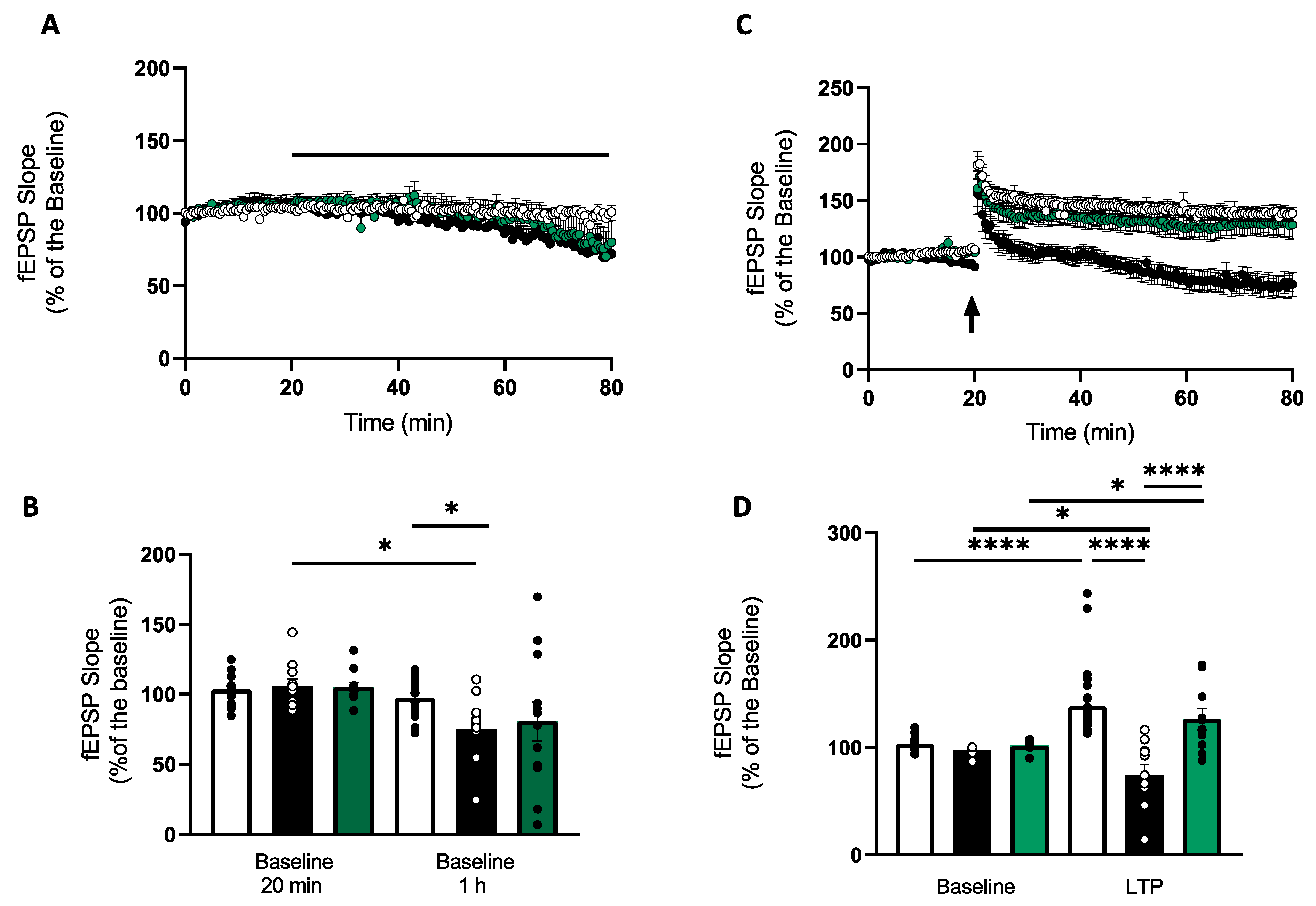
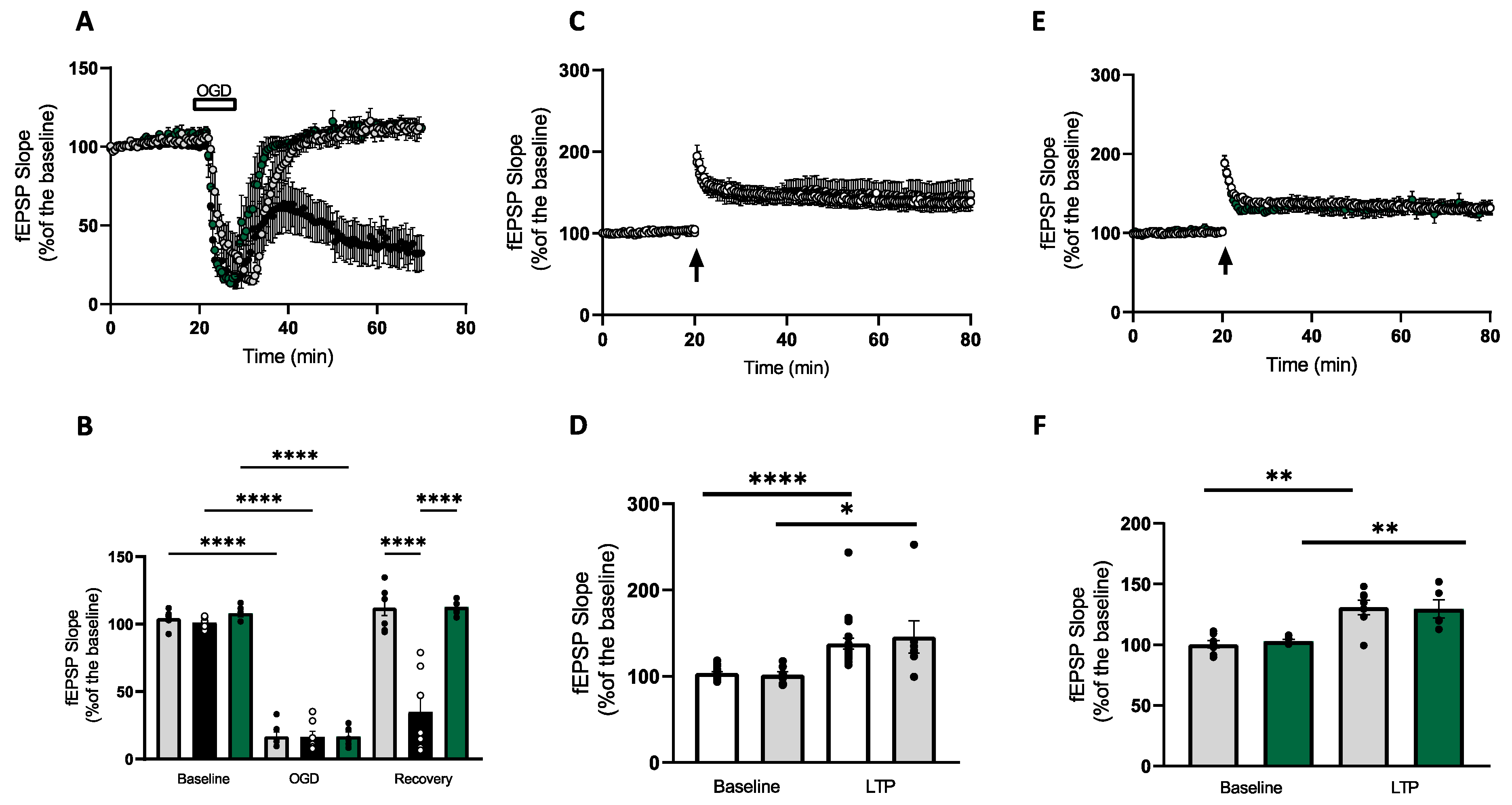
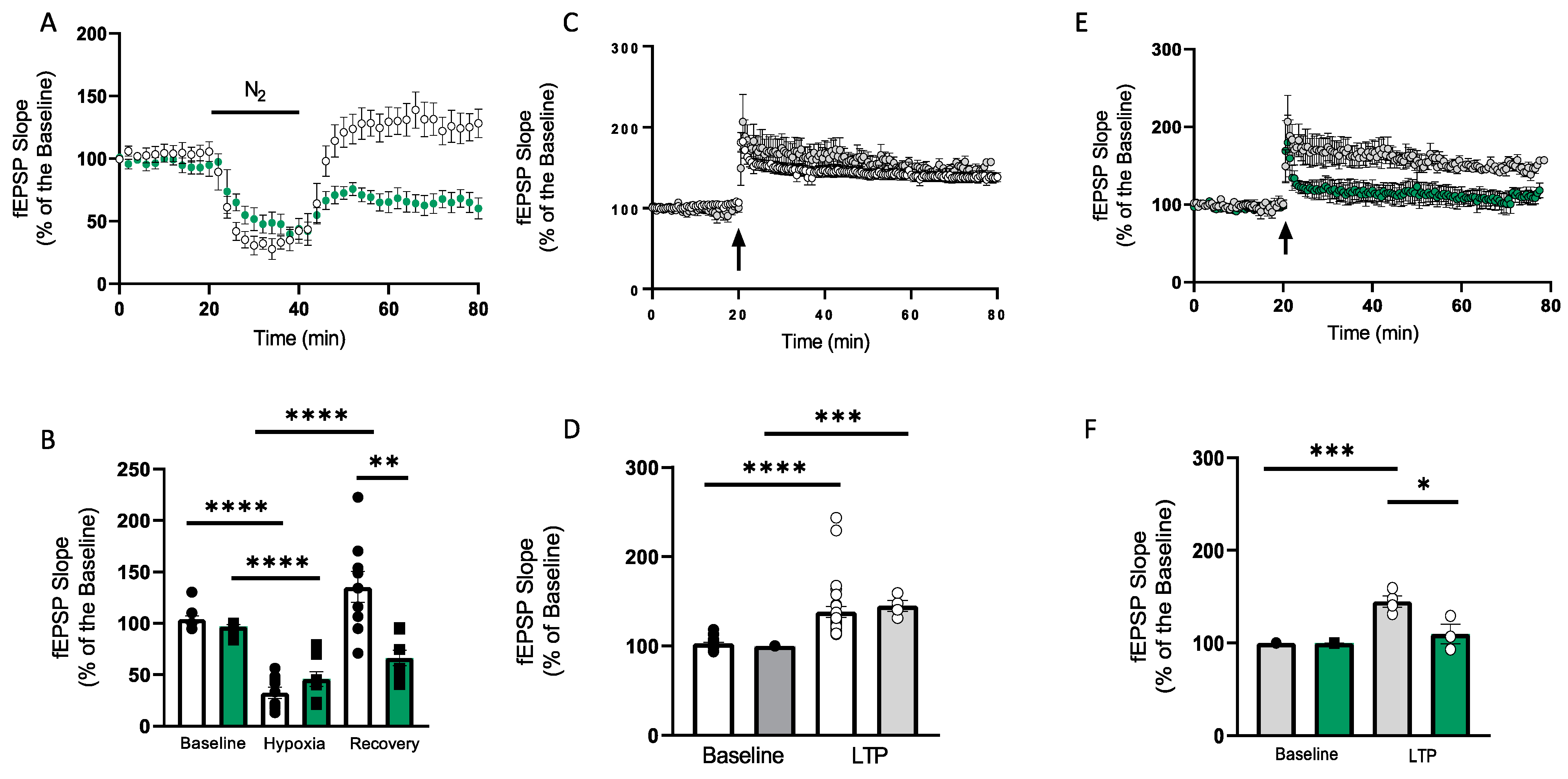
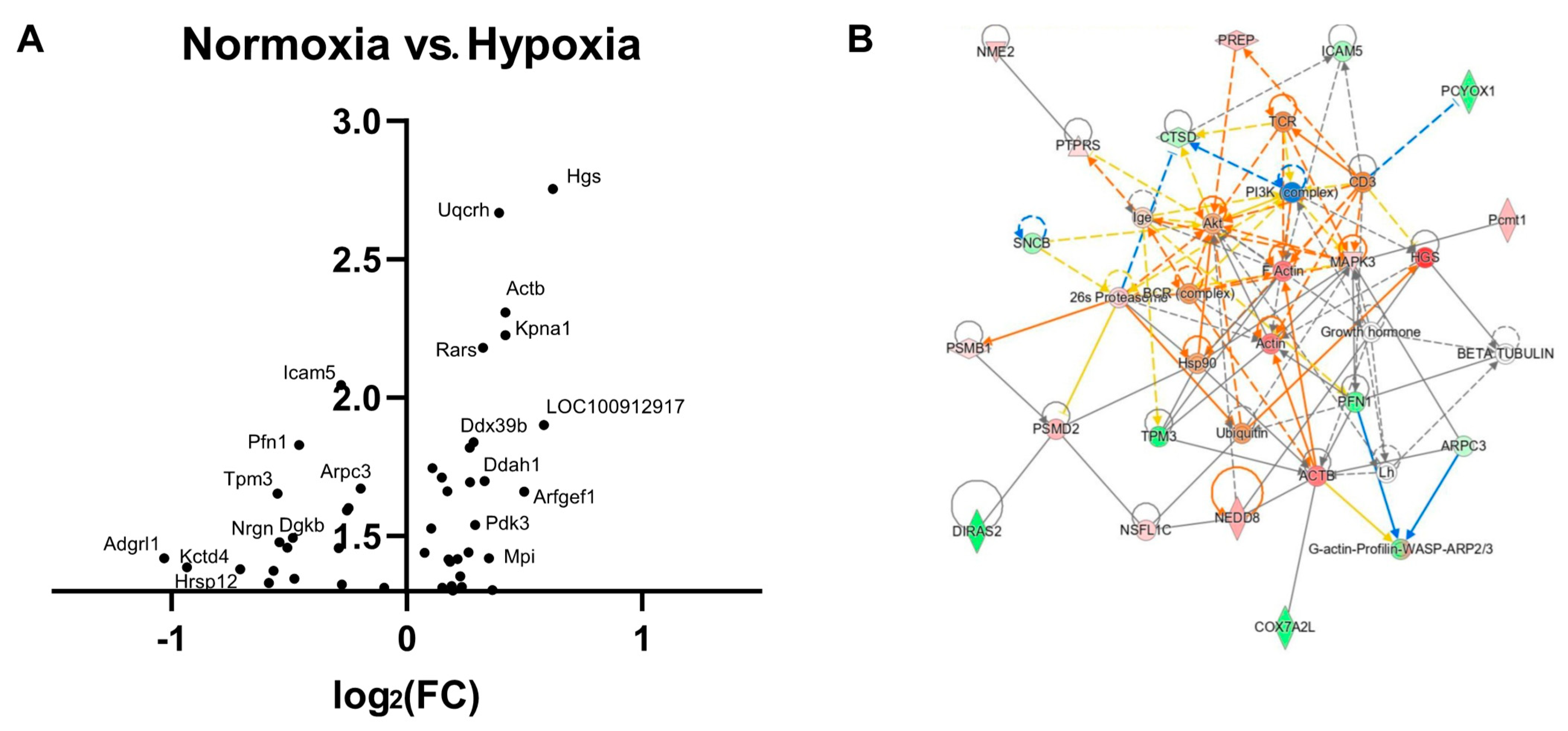
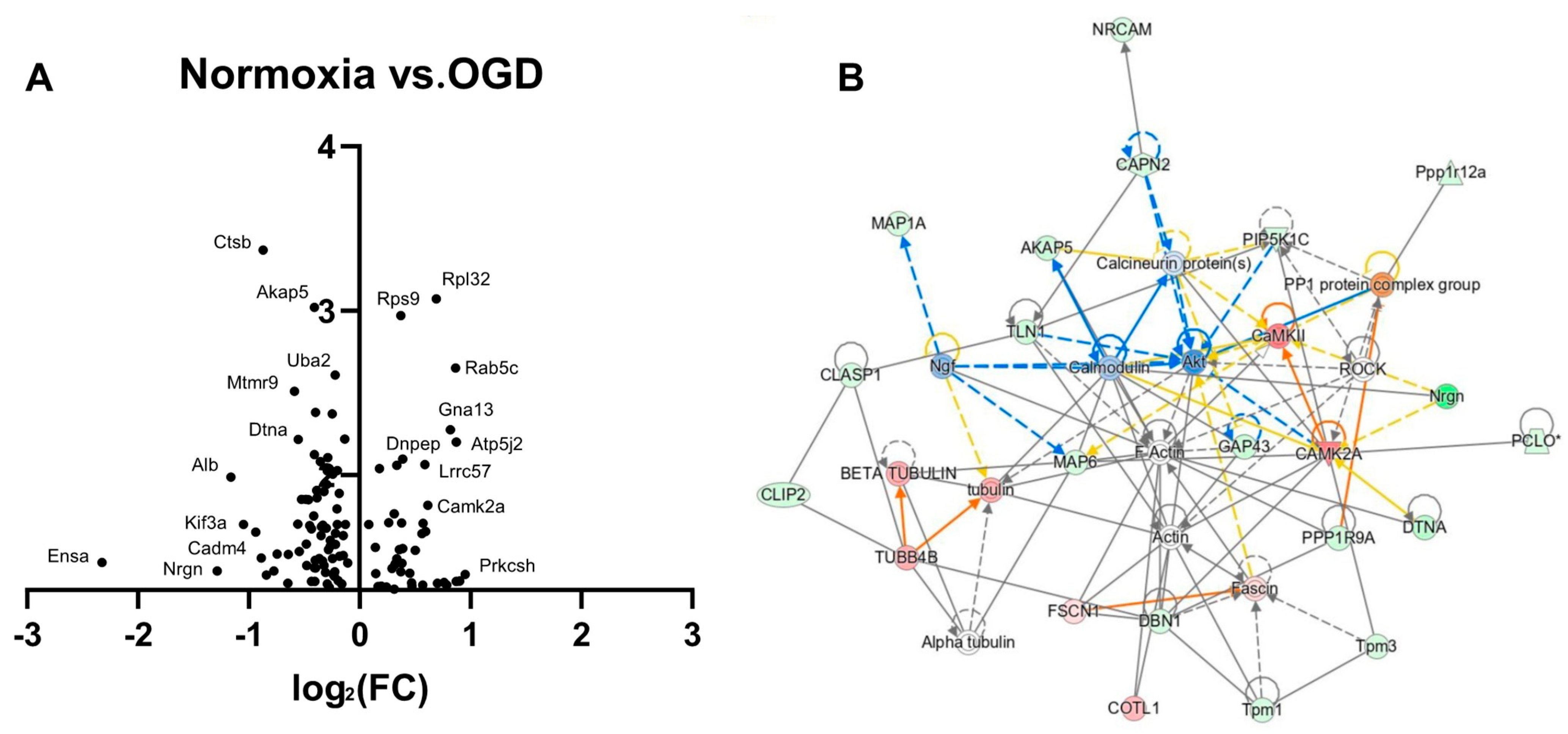
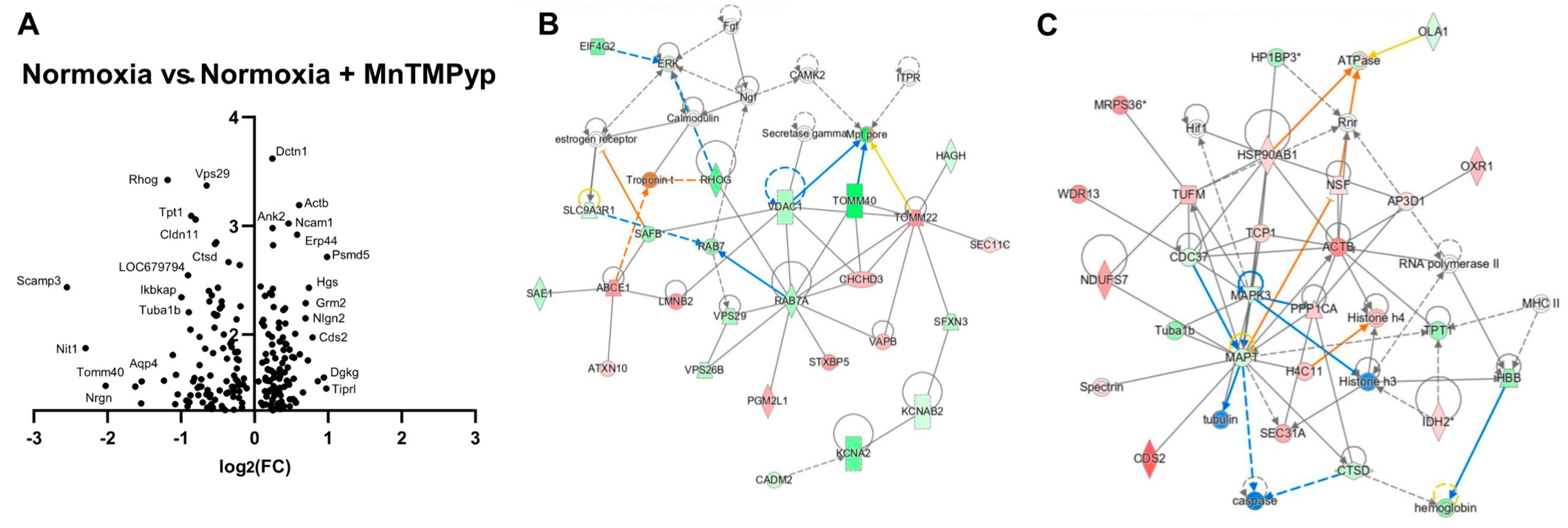
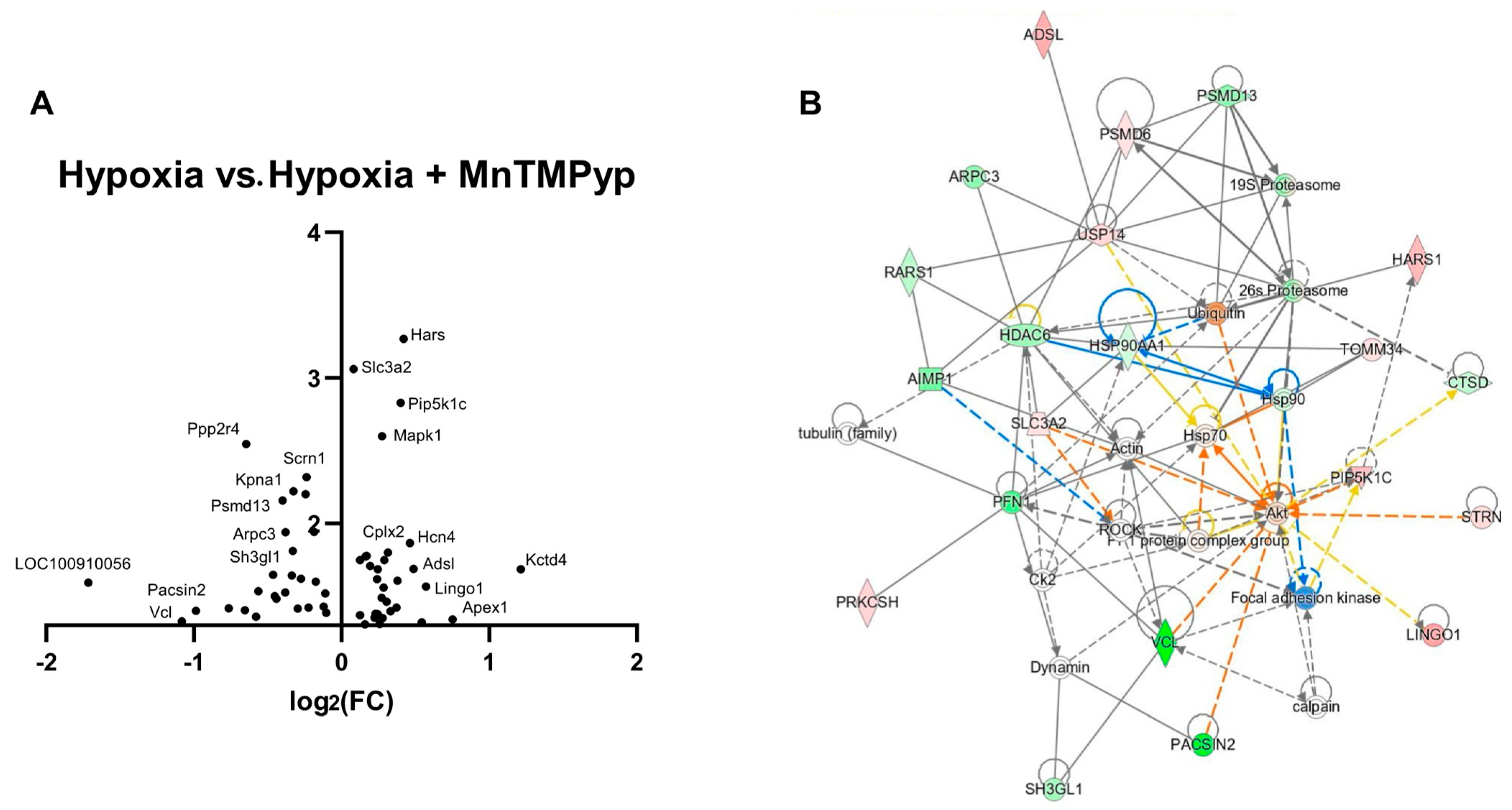
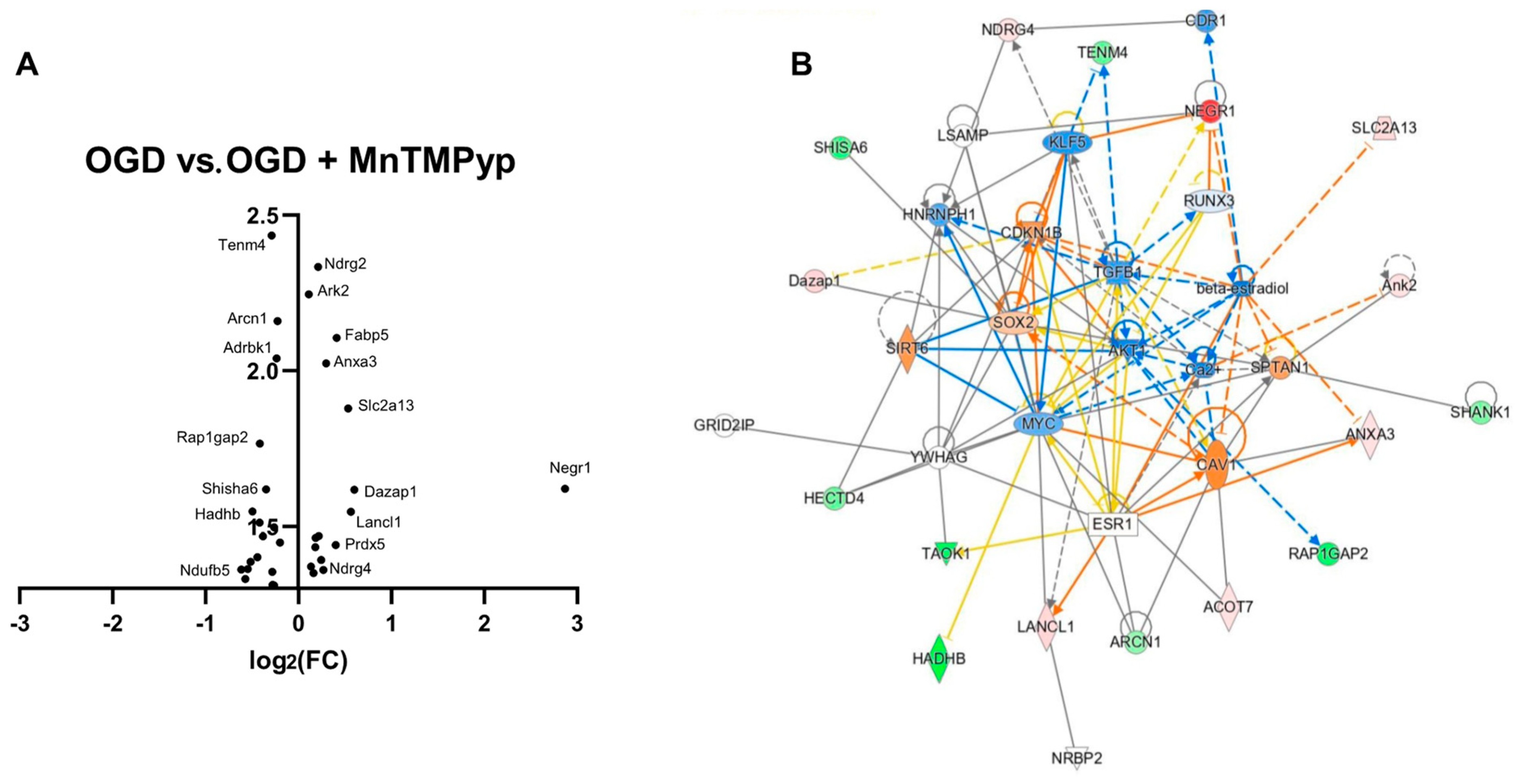
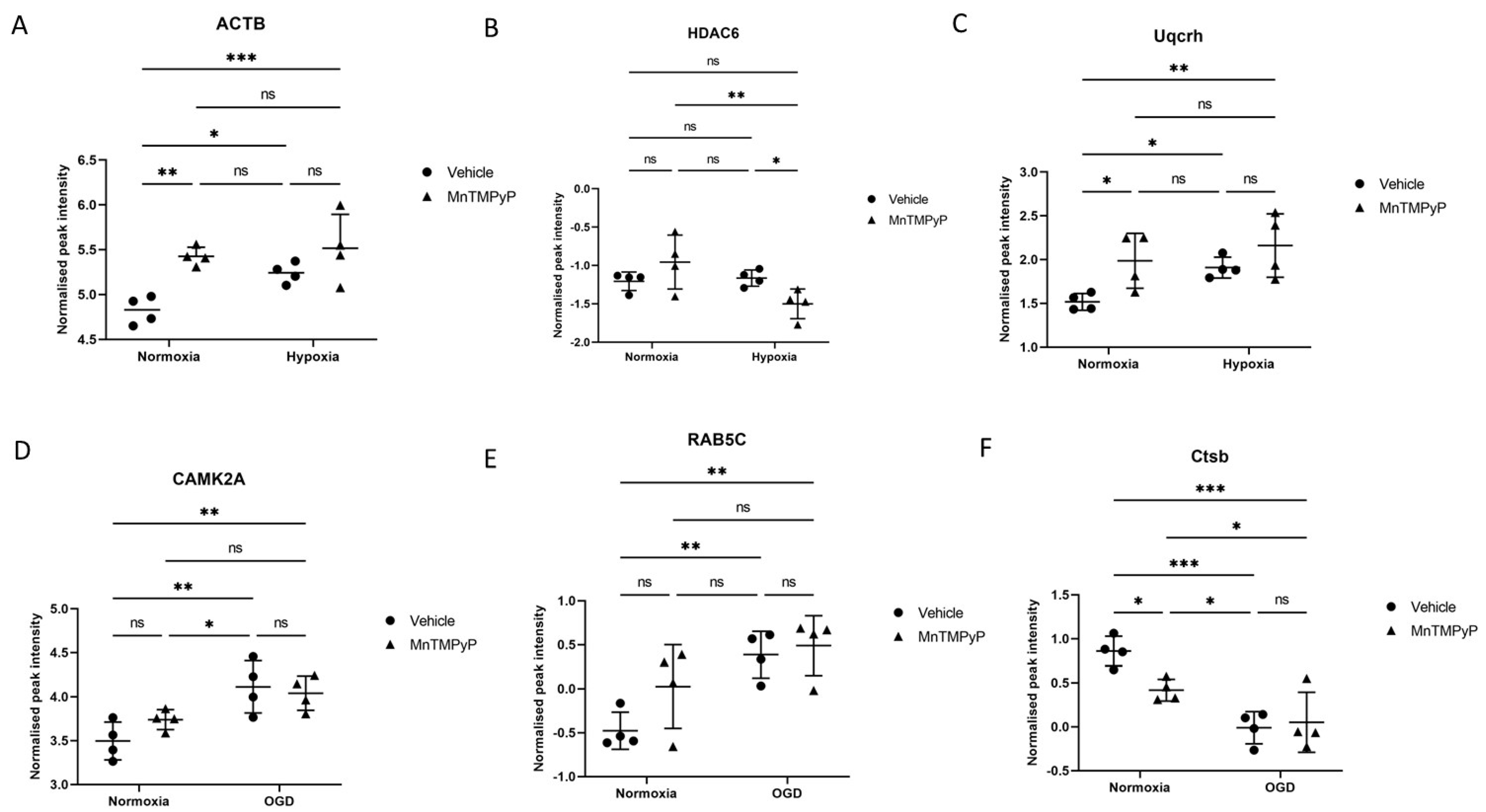
| Ingenuity Canonical Pathways | −Log (p-Value) | z-Score | Ratio | Molecules |
|---|---|---|---|---|
| Fcγ Receptor-mediated Phagocytosis in Macrophages and Monocytes | 6.28 | 1.34 | 0.053 | ACTB, ARPC3, DGKB, MAPK3, TLN2 |
| Integrin Signalling | 4.55 | 0.45 | 0.024 | ACTB, ARPC3, MAPK3, PFN1, TLN2 |
| Actin Cytoskeleton Signalling | 4.26 | 0.45 | 0.021 | ACTB, ARPC3, MAPK3, PFN1, TLN2 |
| Inhibition of ARE-Mediated mRNA Degradation Pathway | 3.79 | 0.025 | MAPK3, PPP2R1A, PSMB1, PSMD2 | |
| Remodelling of Epithelial Adherens Junctions | 3.68 | 0.044 | ACTB, ARPC3, HGS | |
| BAG2 Signalling Pathway | 3.41 | 0.036 | MAPK3, PSMB1, PSMD2 | |
| Clathrin-mediated Endocytosis Signalling | 3.38 | 0.019 | ACTB, ARPC3, HGS, PCYOX1 | |
| Ceramide Signalling | 3.31 | 0.033 | CTSD, MAPK3, PPP2R1A | |
| Salvage Pathways of Pyrimidine Ribonucleotides | 3.23 | 0.031 | AK1, MAPK3, NME2 | |
| Pyrimidine Deoxyribonucleotides De Novo Biosynthesis I | 3.16 | 0.087 | AK1, NME2 | |
| Regulation of Actin-based Motility by Rho | 3.01 | 0.026 | ACTB, ARPC3, PFN1 | |
| RHOA Signalling | 2.92 | 0.024 | ACTB, ARPC3, PFN1 | |
| Huntington’s Disease Signalling | 2.88 | 0.014 | CTSD, MAPK3, PSMB1, PSMD2 | |
| Reelin Signalling in Neurons | 2.78 | 0.022 | ARPC3, MAPK3, PDK3 | |
| D-mannose Degradation | 2.77 | 1 | MPI | |
| Pyrimidine Ribonucleotides Interconversion | 2.72 | 0.053 | AK1, NME2 | |
| Pyrimidine Ribonucleotides De Novo Biosynthesis | 2.66 | 0.049 | AK1, NME2 | |
| Aryl Hydrocarbon Receptor Signalling | 2.61 | 0.019 | CTSD, MAPK3, NEDD8 | |
| Thyroid Hormone Biosynthesis | 2.47 | 0.5 | CTSD | |
| FAT10 Signalling Pathway | 2.39 | 0.036 | PSMB1, PSMD2 | |
| Production of Nitric Oxide and Reactive Oxygen Species in Macrophages | 2.38 | 0.016 | MAPK3, PCYOX1, PPP2R1A | |
| ILK Signalling | 2.32 | 0.015 | ACTB, MAPK3, PPP2R1A | |
| ERK/MAPK Signalling | 2.24 | 0.014 | MAPK3, PPP2R1A, TLN2 | |
| Agrin Interactions at Neuromuscular Junction | 2.21 | 0.029 | ACTB, MAPK3 | |
| Caveolar-mediated Endocytosis Signalling | 2.14 | 0.027 | ACTB, COPB2 | |
| AMPK Signalling | 2.1 | 0.012 | ACTB, AK1, PPP2R1A |
| Ingenuity Canonical Pathways | −Log (p-Value) | z-Score | Ratio | Molecules |
|---|---|---|---|---|
| Protein Kinase A Signalling | 4.27 | 0 | 0.022 | AKAP5, CAMK2A, GNA13, GNB1, PRKAR2B, PTK2B, PTPN23, YWHAG, YWHAH |
| Inhibition of ARE-Mediated mRNA Degradation Pathway | 4.23 | 0.037 | LOC100360846/Psmb6, PRKAR2B, PSMA4, PSMA7, YWHAG, YWHAH | |
| Mitochondrial Dysfunction | 4.02 | 0.71 | 0.023 | CAMK2A, CAPN2, MAOA, MCU, PARK7, PRKAR2B, SOD2, UQCRQ |
| Calcium Signalling | 3.5 | 0.027 | AKAP5, CAMK2A, MCU, PRKAR2B, Tpm1, Tpm3 | |
| BAG2 Signalling Pathway | 3.38 | 0.048 | CTSB, LOC100360846/Psmb6, PSMA4, PSMA7 | |
| Glycine Betaine Degradation | 3.12 | 0.2 | SHMT2, SRR | |
| FAT10 Signalling Pathway | 2.79 | 0.054 | LOC100360846/Psmb6, PSMA4, PSMA7 | |
| Clathrin-mediated Endocytosis Signalling | 2.75 | 0.024 | ALB, CLU, PIP5K1C, RAB5C, SH3GL1 | |
| RHOA Signalling | 2.75 | 0 | 0.032 | GNA13, PIP5K1C, Ppp1r12a, PTK2B |
| ERK/MAPK Signalling | 2.69 | 0.023 | PRKAR2B, PTK2B, TLN1, YWHAG, YWHAH | |
| Ephrin B Signalling | 2.47 | 0.042 | GNA13, GNB1, NCK2 | |
| ERK5 Signalling | 2.44 | 0.041 | GNA13, YWHAG, YWHAH | |
| Chemokine Signalling | 2.33 | 0.037 | CAMK2A, Ppp1r12a, PTK2B | |
| Signalling by Rho Family GTPases | 2.29 | 0.019 | GNA13, GNB1, PIP5K1C, PTK2B, STMN1 | |
| Crosstalk between Dendritic Cells and Natural Killer Cells | 2.19 | 0.033 | CAMK2A, FSCN1, TLN1 | |
| Huntington’s Disease Signalling | 2.18 | 0.018 | CAPN2, GNB1, LOC100360846/Psmb6, PSMA4, PSMA7 | |
| Cardiac β-adrenergic Signalling | 2.17 | 0.022 | AKAP5, GNA13, GNB1, PRKAR2B | |
| Fcγ Receptor-mediated Phagocytosis in Macrophages and Monocytes | 2.15 | 0.032 | NCK2, PTK2B, TLN1 | |
| Oestrogen Receptor Signalling | 2.14 | 0.82 | 0.015 | GNA13, GNB1, MCU, Ppp1r12a, PRKAR2B, SOD2 |
| IL-1 Signalling | 2.12 | 0.031 | GNA13, GNB1, PRKAR2B | |
| Glycine Biosynthesis I | 2.08 | 0.5 | SHMT2 | |
| GNRH Signalling | 2.08 | 0 | 0.021 | CAMK2A, GNB1, PRKAR2B, PTK2B |
| Xenobiotic Metabolism PXR Signalling Pathway | 2.07 | −1 | 0.021 | CAMK2A, GSTM5, MAOA, PRKAR2B |
| IGF-1 Signalling | 2.02 | 0.029 | PRKAR2B, YWHAG, YWHAH | |
| Paxillin Signalling | 2 | 0.028 | NCK2, PTK2B, TLN1 |
| Ingenuity Canonical Pathways | −Log (p-Value) | z-Score | Ratio | Molecules |
|---|---|---|---|---|
| Synaptogenesis Signalling Pathway | 7.2 | 0.53 | 0.044 | ARHGEF7, ARPC3, ARPC4, GRIA1, GRM2, MAPK1, MAPK3, MAPT, NAPB, NLGN2, NRXN1, NSF, PRKCE, STXBP5 |
| BAG2 Signalling Pathway | 6.81 | 0 | 0.095 | CTSB, MAPK1, MAPK3, MAPT, PSMA3, PSMB4, PSMC5, PSMD5 |
| Mitochondrial Dysfunction | 5.91 | −1.39 | 0.038 | ATP1A2, ATP1B3, Cox7a2/Cox7a2l2, COX7A2L, CYB5A, IDH2, MAOA, MAOB, MAPT, NDUFS7, TOMM22, TOMM40, VDAC1 |
| Integrin Signalling | 5.52 | −0.33 | 0.047 | ACTB, ARF6, ARHGEF7, ARPC3, ARPC4, GIT1, MAPK1, MAPK3, PFN1, RHOG |
| Fcγ Receptor-mediated Phagocytosis in Macrophages and Monocytes | 5.3 | 1.13 | 0.075 | ACTB, ARF6, ARPC3, ARPC4, MAPK1, MAPK3, PRKCE |
| Huntington’s Disease Signalling | 5.21 | 0.039 | CTSD, DCTN1, MAPK1, MAPK3, NAPB, NSF, PRKCE, PSMA3, PSMB4, PSMC5, PSMD5 | |
| Remodelling of Epithelial Adherens Junctions | 5.04 | 0.45 | 0.088 | ACTB, ARF6, ARPC3, ARPC4, HGS, RAB7A |
| Clathrin-mediated Endocytosis Signalling | 4.72 | 0.043 | ACTB, ALB, AP3D1, ARF6, ARPC3, ARPC4, CLU, HGS, RAB7A | |
| Sirtuin Signalling Pathway | 4.3 | 0.38 | 0.034 | H4C11, IDH2, MAP1LC3A, MAPK1, MAPK3, NDUFS7, PGAM1, TOMM22, TOMM40, VDAC1 |
| Actin Cytoskeleton Signalling | 4.18 | 0.71 | 0.037 | ACTB, ARHGEF7, ARPC3, ARPC4, CYFIP1, GIT1, MAPK1, MAPK3, PFN1 |
| Ingenuity Canonical Pathways | −Log (p-Value) | z-Score | Ratio | Molecules |
|---|---|---|---|---|
| Huntington’s Disease Signalling | 8.05 | 0.032 | CPLX2, CTSD, GNG3, HDAC6, MAPK1, NAPB, PSMD13, PSMD6, SDHA | |
| Sirtuin Signalling Pathway | 7.92 | 0.82 | 0.031 | APEX1, MAPK1, NDUFA10, NDUFA9, PGAM1, SDHA, SOD2, TIMM9, TOMM34 |
| Oestrogen Receptor Signalling | 4.57 | 0.017 | GNG3, HSP90AA1, MAPK1, NDUFA10, NDUFA9, SDHA, SOD2 | |
| BAG2 Signalling Pathway | 4.48 | 0.048 | HSP90AA1, MAPK1, PSMD13, PSMD6 | |
| Mitochondrial Dysfunction | 4.01 | −2.45 | 0.017 | NDUFA10, NDUFA9, OPA1, SDHA, SOD2, TOMM34 |
| Actin Cytoskeleton Signalling | 3.74 | −0.45 | 0.021 | ARPC3, MAPK1, PFN1, PIP5K1C, VCL |
| Neutrophil Extracellular Trap Signalling Pathway | 3.59 | 2.45 | 0.015 | MAPK1, NDUFA10, NDUFA9, SDHA, TIMM9, TOMM34 |
| Granzyme A Signalling | 3.24 | 0.04 | APEX1, NDUFA10, NDUFA9 | |
| Clathrin-mediated Endocytosis Signalling | 2.98 | 0.019 | AP3D1, ARPC3, PIP5K1C, SH3GL1 | |
| Integrin Signalling | 2.94 | −1 | 0.019 | ARPC3, MAPK1, PFN1, VCL |
| Ingenuity Canonical Pathways | −Log (p-Value) | z-Score | Ratio | Molecules |
|---|---|---|---|---|
| Granzyme A Signalling | 2.39 | 0.027 | NDUFB5, NDUFB9 | |
| Oxidative Phosphorylation | 2.06 | 0.018 | NDUFB5, NDUFB9 | |
| Regulation of Actin-based Motility by Rho | 2.03 | 0.017 | CFL1, PFN1 |
Disclaimer/Publisher’s Note: The statements, opinions and data contained in all publications are solely those of the individual author(s) and contributor(s) and not of MDPI and/or the editor(s). MDPI and/or the editor(s) disclaim responsibility for any injury to people or property resulting from any ideas, methods, instructions or products referred to in the content. |
© 2023 by the authors. Licensee MDPI, Basel, Switzerland. This article is an open access article distributed under the terms and conditions of the Creative Commons Attribution (CC BY) license (https://creativecommons.org/licenses/by/4.0/).
Share and Cite
Puzio, M.; Moreton, N.; Sullivan, M.; Scaife, C.; Glennon, J.C.; O’Connor, J.J. An Electrophysiological and Proteomic Analysis of the Effects of the Superoxide Dismutase Mimetic, MnTMPyP, on Synaptic Signalling Post-Ischemia in Isolated Rat Hippocampal Slices. Antioxidants 2023, 12, 792. https://doi.org/10.3390/antiox12040792
Puzio M, Moreton N, Sullivan M, Scaife C, Glennon JC, O’Connor JJ. An Electrophysiological and Proteomic Analysis of the Effects of the Superoxide Dismutase Mimetic, MnTMPyP, on Synaptic Signalling Post-Ischemia in Isolated Rat Hippocampal Slices. Antioxidants. 2023; 12(4):792. https://doi.org/10.3390/antiox12040792
Chicago/Turabian StylePuzio, Martina, Niamh Moreton, Mairéad Sullivan, Caitriona Scaife, Jeffrey C. Glennon, and John J. O’Connor. 2023. "An Electrophysiological and Proteomic Analysis of the Effects of the Superoxide Dismutase Mimetic, MnTMPyP, on Synaptic Signalling Post-Ischemia in Isolated Rat Hippocampal Slices" Antioxidants 12, no. 4: 792. https://doi.org/10.3390/antiox12040792
APA StylePuzio, M., Moreton, N., Sullivan, M., Scaife, C., Glennon, J. C., & O’Connor, J. J. (2023). An Electrophysiological and Proteomic Analysis of the Effects of the Superoxide Dismutase Mimetic, MnTMPyP, on Synaptic Signalling Post-Ischemia in Isolated Rat Hippocampal Slices. Antioxidants, 12(4), 792. https://doi.org/10.3390/antiox12040792








